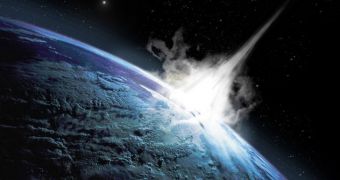Scientists speaking at this year's Goldschmidt geochemistry conference this past June 11 announced that, according to evidence at hand, it was possible that, millions of years ago, a meteor collided with our planet and triggered a mass extinction.
The mass extinction that the University of California, Los Angeles, researchers have in mind happened about 33.7 million years ago, and the widely accepted view is that it was brought about by natural changes in global environmental conditions.
However, it appears that, all things considered, it might very well be that the Eocene epoch mass extinction was not caused by climate change, but was the result of a really impressive meteor crash.
As detailed by Live Science, specialists now saying that the Eocene epoch mass extinction might have been caused by a meteor crash base their claim on information obtained while analyzing the Popigai impact crater in Siberia.
This crater in Russia is listed among our planet's 10 biggest impact craters. Thus, it measures about 100 kilometers (62 miles) across, and previous studies argued that it was created about 35 million years ago, the University of California, Los Angeles, specialists explain.
However, an analysis of rock found beneath the impact crater has shown that, contrary to long held assumptions, it is possible that the crater came into being about the same time as the Eocene epoch mass extinction, i.e. 33.7 million years ago.
If this is indeed the case, it can be argued that said extinction was caused by a so-called impact winter brought about by a meteor crash. “I don't think this will be the smoking gun, but it reopens the door to Popigai being involved in the mass extinction,” specialist Matt Wielicki nonetheless stresses.
Matt Wielicki and fellow researchers suspect that, in the aftermath of the meteor crash that birthed the Popigai impact crater, loads of sun-reflecting particles ended up floating about in our planet's atmosphere. This caused global temperatures to drop to a considerable extent.
As a result, about 90% of the species that inhabited our planet at that time fell off the biodiversity map. It is this event that the scientific community calls the Eocene mass extinction, and that need be blamed for the fact that biodiversity in this day and age looks very different to the one millions of years ago.
Interestingly enough, the Popigai impact crater in Siberia is not the only suspect behind the Eocene mass extinction. On the contrary, the Chesapeake Bay crater offshore Virginia, the Toms Canyon crater offshore New Jersey, and the Mistastin crater in Labrador, Canada, are also on the list of possible culprits.

 14 DAY TRIAL //
14 DAY TRIAL //